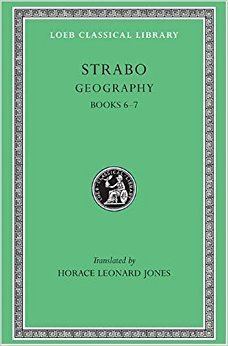Originally published 1853 | ||
 | ||
Geography books Geography, Eratosthenes' "Geography", Everyday Life in Babylon | ||
The Geographica (Ancient Greek: Γεωγραφικά Geōgraphiká), or Geography, is an encyclopedia of geographical knowledge, consisting of 17 'books', written in Greek by Strabo, an educated citizen of the Roman Empire of Greek descent. Work can have begun on it no earlier than 20 BC. A first edition was published in 7 BC followed by a gap, resumption of work and a final edition no later than 23 AD in the last year of Strabo's life. Strabo probably worked on his Geography and now missing History concurrently, as the Geography contains a considerable amount of historical data. Except for parts of Book 7, the complete work is known.
Contents
Title of the work
Strabo refers to his Geography within it by several names:
Apart from the "outline", two words recur, "earth" and "country." Something of a theorist, Strabo explains what he means by Geography and Chorography:
It is the sea more than anything else that defines the contours of the land (geōgraphei) and gives it its shape, by forming gulfs, deep seas, straits and likewise isthmuses, peninsulas, and promontories; but both the rivers and the mountains assist the seas herein. It is through such natural features that we gain a clear conception of continents, nations, favourable positions of cities and all the other diversified details with which our geographical map (chorographikos pinax) is filled.
From this description it is clear that by geography Strabo means ancient physical geography and by chorography, political geography. The two are combined in this work, which makes a "circuit of the earth" detailing the physical and political features. Strabo often uses the adjective geōgraphika with reference to the works of others and to geography in general, but not of his own work. In the Middle Ages it became the standard name used of his work.
Date
The date of Geographica is a large topic, perhaps because Strabo worked on it along with his History for most of his adult life. He traveled extensively, undoubtedly gathering notes, and made extended visits to Rome and Alexandria, where he is sure to have spent time in the famous library taking notes from his sources.
Strabo visited Rome in 44 BC at age 19 or 20 apparently for purposes of education. He studied under various persons, including Tyrannion, a captive educated Greek and private tutor, who instructed Cicero's two sons. Cicero says:
The geographical work I had planned is a big undertaking...if I take Tyrannion's views too...
If one presumes that Strabo acquired the motivation for writing geography during his education, the latter must have been complete by the time of his next visit to Rome in 35 BC at 29 years old. He may have been gathering notes but the earliest indication that he must have been preparing them is his extended visit to Alexandria 25–20 BC. In 20 he was 44 years old. His "numerous excerpts" from "the works of his predecessors" are most likely to have been noted at the library there. Whether these hypothetical notes first found their way into his history and then into his geography or were simply ported along as notes remains unknown.
Most of the events of the life of Augustus mentioned by Strabo occurred 31–7 BC with a gap 6 BC – 14 AD, which can be interpreted as an interval after first publication in 7 BC. Then in 19 AD a specific reference dates a passage: he said that the Carni and Norici had been at peace since they were "stopped ... from their riotous incursions ...." by Drusus 33 years ago, which was 15 BC, dating the passage 19 AD. The latest event mentioned is the death of Juba at no later than 23 AD, when Strabo was in his 80's. These events can be interpreted as a second edition unless he saved all his notes and wrote the book entirely after the age of 80.
Composition
Strabo is his own best expounder of his principles of composition:
In short, this book of mine should be ... useful alike to the statesman and to the public at large – as was my work on History. ... And so, after I had written my Historical Sketches ... I determined to write the present treatise also; for this work is based on the same plan, and is addressed to the same class of readers, and particularly to men of exalted stations in life. ... in this work also I must leave untouched what is petty and inconspicuous, and devote my attention to what is noble and great, and to what contains the practically useful, or memorable, or entertaining. ... For it, too, is a colossal work, in that it deals with the facts about large things only, and wholes ....
Subject matter
An outline of the encyclopedia follows, with links to the appropriate Wikipedia article.
Book I – definition and history of geography
Pages C1 through C67, Loeb Volume I pages 3–249.
Publications
Some thirty manuscripts of Geographica or parts of it have survived, almost all of them medieval copies of copies, though there are fragments from papyrus rolls which were probably copied out c. 100–300 AD. Scholars have struggled for a century and a half to produce an accurate edition close to what Strabo wrote. A definitive one has been in publication since 2002, appearing at a rate of about a volume a year.
